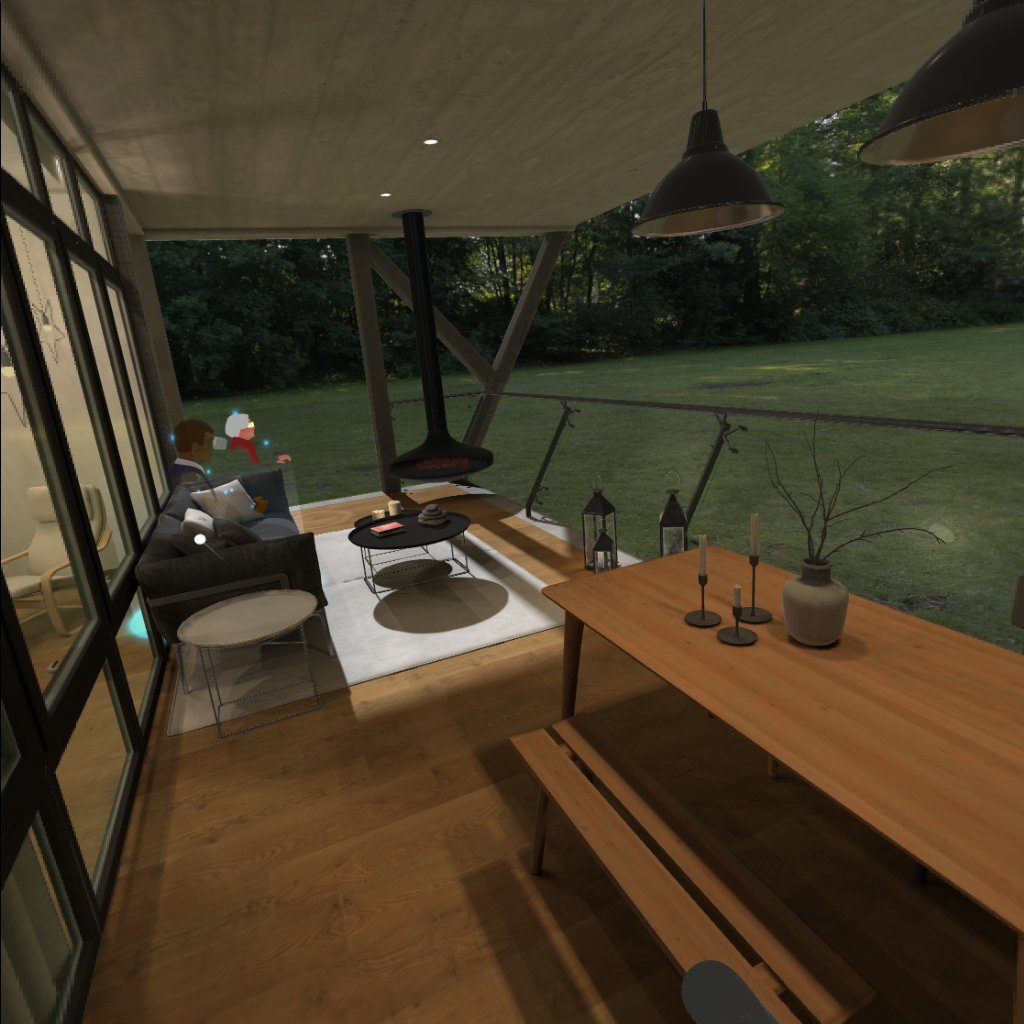Tuesday 30 June 2020
VR wearable can simulate temperature changes using odorless chemicals
Simulating temperature with smells? Turns out it works
from Virtual Reality | Digital Trends https://ift.tt/2ZnhD1v
via IFTTT
VR Mil-Sim ‘Onward’ Oculus Quest Release Date Announced, Cross-Play Confirmed
Check out the brand new trailer for this highly-anticipated standalone port.
A little more than a year after the initial announcement, developer Downpour Interactive and publisher Coatsink today revealed an official July 30th release date for Onward on Oculus Quest. Standalone players will soon have the chance to team-up with PC VR players on high-stakes missions in which proper coordination and planning can mean the difference between life and death.
“I’m incredibly excited for Onward to come to the Oculus Quest: to have players be inspired by the freedom of the platform while at the same time experiencing the realism and immersion that Onward brings to the table,” said Dante Buckley, Founder of Downpour Interactive. “And I think I speak for my whole team when I say we’re excited to see our players get their hands on the game after almost a year of development.”
Much like the existing Oculus Rift and SteamVR platform version, the standalone port will feature both single-player and cooperative game modes, each of which featuring their own unique objectives. Hunt, for instance, tasks you with tracking down and eliminating all AI enemies on the map. Evac, on the other hand, has you defending your position against waves of enemies as you await your extraction.
Of course it wouldn’t be Onward without the hardcore online multiplayer. Each of these 10-player matches revolve around completing one of three objectives. 1.) Gain control of an Uplink station. 2.) Escort a VIP to safety. 3.) Secure a designated location and upload a code from your tablet.
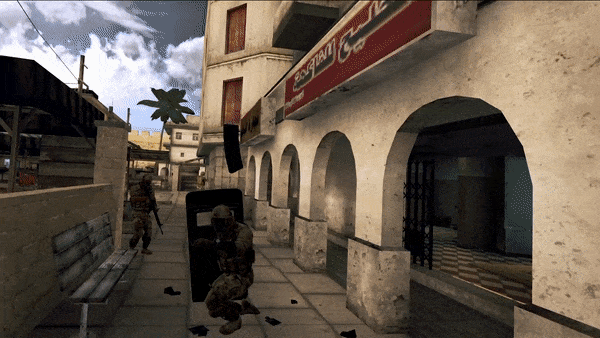
Before hopping into battle, you can familiarize yourself with the massive selection of realistic weaponry at your disposal in the shooting range. Here you can get unlimited hand-on time with weapons such as the AUG, M16, M1014, P90, M249 light machine gun, AKS74U, Makarov, and RPG launcher.
Onward launches July 30th on the Oculus Quest Store for $24.99. For more information visit downpourinteractive.com.
Image Credit: Downpour Interactive, Coatsink
The post VR Mil-Sim ‘Onward’ Oculus Quest Release Date Announced, Cross-Play Confirmed appeared first on VRScout.
from VRScout https://ift.tt/3dKebmF
via IFTTT
Oculus Quest Gets Voice Commands For U.S. English
Oculus Quest’s latest system software makes voice commands available as a beta feature to United States-based English speakers.
Version 18 of Oculus Quest software is beginning to roll out this week and if you have the redesigned universal menu on your Quest “you can find it in Settings > Quick Actions > Voice Commands. The Voice Commands icon is located next to the Microphone icon. Otherwise, you can find it directly in your Oculus home menu.”
You can activate the feature by clicking an icon in the Oculus menu or enabling a shortcut where you double press the Oculus button to activate voice commands. Available commands include “Take a photo” to snap a screenshot while you’re in a virtual world, “start casting” to mirror the headset’s view to another screen, or “turn off” to shut down the headset. “What can I say?” will show you examples of other available commands.
Quest’s software continues to become more feature-filled with new releases pushed out by Facebook. In recent weeks the company made it possible to set up a room-scale boundary with just hand tracking, to change the color of the barrier, and get alerted during room setup to possible objects in your space.
We don’t have the v18 update to Quest just yet to test this out. If you do have the feature already, please let us know in the comments what you think of voice commands on Oculus Quest. Facebook typically rolls out its updates over several days to ensure stability of the release.
The post Oculus Quest Gets Voice Commands For U.S. English appeared first on UploadVR.
from UploadVR https://ift.tt/2VyrOza
via IFTTT
Onward Oculus Quest Release Date Announced!
The post Onward Oculus Quest Release Date Announced! appeared first on UploadVR.
from UploadVR https://ift.tt/3eNuhNN
via IFTTT
You Can Now Change Oculus Quest’s Guardian Boundary Color
Oculus Quest’s Guardian boundary can now be changed to yellow or purple, if you’re not a fan of the default blue.
This feature was announced back in mid-May. Six weeks later it’s now “rolling out” as part of the system software v18 update.

To change the Oculus Quest Guardian color, just navigate to the Guardian tab.

This isn’t the only update we’ve seen to Guardian recently. Since May, it can now detect objects in your playspace when you first put the headset on in a play session. We’ve even noticed it detecting dogs & cats. It can’t yet warn about these while in VR, however.
The PC-based Oculus Rift S also features the Guardian system, and uses the same versioning system. However, color options are not available on Rift S software v18. Valve’s SteamVR offers a wide variety of colors for ‘Chaperone’, its competing system.
Will you be changing your Guardian color? Or do you want a color not available yet? Let us know in the comments below!
The post You Can Now Change Oculus Quest’s Guardian Boundary Color appeared first on UploadVR.
from UploadVR https://ift.tt/2Aibdbv
via IFTTT
Creating Real Family Memories Under Lockdown With The Alcove VR App
Travel the globe, share family photos, and play games with loved ones of all ages in this unique social VR experience.
Connecting with family isn’t always easy, especially in today’s climate. The global outbreak of COVID-19 has led to the government-mandated lockdowns around the world, separating countless families, friends, and loved ones in the process. Now more than ever we find ourselves in desperate need of human connection. This is where Alcove comes in.
Available free on Facebook’s Oculus Go VR headset, AARP Innovation Labs’ Alcove is a brand new social platform that allows up to four loved ones to connect in VR for some good old-fashioned family time. Only instead of sitting down in the den, friends and siblings connect via their own virtual home where they can participate in a wide variety of interactive games and experiences perfect for users of all ages.

Upload family photos, both 2D and 360-degree, and sit down for a next-gen slideshow; meet up and explore the Swiss Alps from the comfort of a flying hot air balloon; participate in immersive mediation and a variety of brain-building activities; customize your virtual home with family photos; or kick back and enjoy some compelling AARP TV, articles, and documentaries. You can even upload your own videos and host a virtual screening of your favorite home movies.
Each room of your virtual home features new gateways to explore. By selecting the world map, for instance, you can teleport to exotic locations around the globe, from Tokyo and Rome to Vienna and Prague. Or you can just head to the living room for a game of checkers.

Alcove is more than just a social VR platform, however. The app is designed to combat social isolation by allowing friends and families members to connect in a more intimate way, regardless of age. As a result, many of the activities and features included as part of Alcove have been tailor-made for more seasoned users who may be less comfortable with VR technology. This includes a handful of health & wellness applications ranging from therapeutic exercises to cognitive training games, each of which aimed at keeping your brain active and sharp.
Whereas the rapid development of modern technology can often drive a wedge between the different generations, Alcove represents a rare opportunity to bridge us together, offering a virtual “middle ground” of sorts that resonates with all ages. It’s not often you come across a VR experience capable of pleasing both the grandkids as well as the grandparents, which is exactly what makes Alcove such an effective platform.
The Alcove beta is available free via the Oculus Go, Facebook’s 3DoF standalone headset. Still in it’s early stage, users can expect a regular series of updates as AARP Innovation Labs continues to introduce new content in the form of additional experiences and features.
For more information on Alcove and its many use-cases, visit alcovevr.com.
This post was created in partnership with Alcove, a product created by AARP Innovation Labs.
Image Credit: AARP Innovation Labs
The post Creating Real Family Memories Under Lockdown With The Alcove VR App appeared first on VRScout.
from VRScout https://ift.tt/2NFDRGD
via IFTTT
‘Onward’ is Coming to Oculus Quest July 30th with PC VR Cross-play, Trailer Here

Downpour Interactive and Coatsink today announced that Onward, the VR tactical shooter, is coming to Oculus Quest on July 30th.
Downpour Interactive founder Dante Buckley first announced the studio was making a Quest port of Onward back at last year’s ESL VR League Season three championship, stating that the game would would feature cross-play with both Oculus Rift and SteamVR headsets.
The studio has made good on its word, and in the meantime also included Coatsink, the studio behind the Esper VR series and Shadow Point (2019), as publisher.
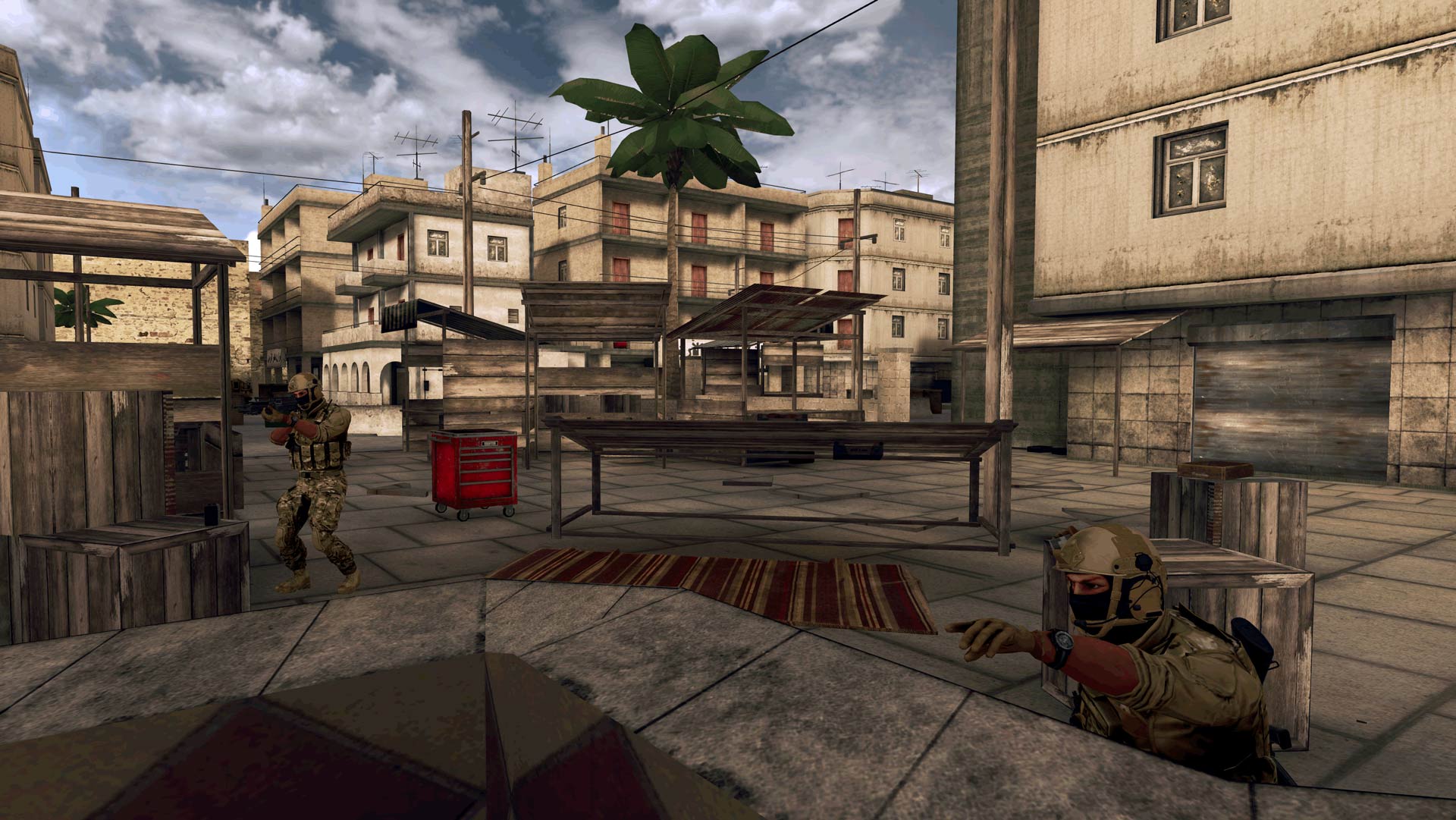
“I’m incredibly excited for Onward to come to the Oculus Quest: to have players be inspired by the freedom of the platform while at the same time experiencing the realism and immersion that Onward brings to the table. And I think I speak for my whole team when I say we’re excited to see our players get their hands on the game after almost a year of development,” said Buckley.
The Quest version is said to include all of the game’s standard features, including solo and co-op game modes, and multiplayer battles with up to ten players. Bringing a greater focus on realism, Onward doesn’t include mini-maps, or crosshairs, as players rely on real-world communication, shooting, and navigation skills to accomplish objectives.
The release on Quest will, like its PC VR versions, be available in Early Access when it first launches on the Oculus Store on July 30th, priced at $25.
There’s no time frame on when the game is said to leave EA, as the studio says it still needs to add “finishing touches, improving stability, optimisations to the game’s source code, and general polish.”
The post ‘Onward’ is Coming to Oculus Quest July 30th with PC VR Cross-play, Trailer Here appeared first on Road to VR.
from Road to VR https://ift.tt/2YJbD3U
via IFTTT
Google Acquires North, the Startup Behind ‘Focals’ Smartglasses

Google today confirmed in a blog post that it’s acquired North, the Canada-based smartglasses maker behind Focals. The acquisition price wasn’t disclosed, however early reports suggested it was around $180 million.
Founded in 2012, North (ex-Thalmic Labs) first set out to create Myo, a gesture-based armband. Pivoting from Myo and rebranding to North in 2018, the company then released Focals, which focused on creating a stylish, unobtrusive pair of prescription-compatible smartglasses.
“Over the last while, it became clear that aligning with Google would significantly advance our shared vision,” North said in a news brief.
The company says that it will be winding down support for its 2018 Focals smartglasses, and that Focals 2.0 is effectively cancelled.
North seems to be making a clean break with its legacy product, Focals 1.0. Starting July 31st, 2020, users won’t able to connect or use Focals or access their North accounts. The Focals app itself is also going to be removed from both Google Play and Apple’s App Store.
Refunds are being offered, as the company says in an FAQ that “[f]ull refunds will be given for all paid Focals orders starting June 30th, 2020 using the original payment method.”
The acquisition seems to have been a fairly quick deal, as North was talking up Focals 2.0 up until March 2020, advertising its prospective 2020 ship date.
This, you might conclude, may mean that Google is getting ready to completely integrate the IP somehow into its own Google Glass project, which has reemerged to serve the enterprise sector. It may equally as well rebrand Focals 2.0 as a Google device targeted at fashion-conscious consumers.
Is Google heading back into consumer smartglasses territory with its latest acquisition? Let us know what you think in the comments below.
The post Google Acquires North, the Startup Behind ‘Focals’ Smartglasses appeared first on Road to VR.
from Road to VR https://ift.tt/3eQ1eZO
via IFTTT
Dreams PSVR Support Becomes A Reality This July With Free Update
After years of teases and then finally a full non-VR release earlier this year, Dreams is finally getting its long-awaited PSVR support on July 22nd, 2020 as a free update.
Until right now the last we had heard about Dreams PSVR support was that it was in the final QA and bug fixing phase back in late April and then VR user testing in May. Two months later, it sounds like the work is finally completed as the update preps for launch.
Ever since Dreams was first announced for PS4 years ago, Media Molecule and Sony have always trumpeted that it would work with PSVR. It didn’t launch with that support, but it’ll be there in less than a month as a free update.
According to today’s PS blog post, this update also will include brand new VR-focused tutorials, how-tos, comfort modes, and kits for creating PSVR games, as well as new content from Media Molecule themselves. When in Create mode, sculpting becomes a much more tactile experience if you have PS Move Controllers as you can use your hands for a one-to-one interactive experience as you build. Interestingly, you do not “need” to be in VR to create for PSVR.
Personally, I’m pretty terrible at making things in these types of games. I never finished anything worth playing in LittleBigPlanet, couldn’t get into Minecraft, then crashed and burned hard in non-VR Dreams. But in the hands of the right people, Dreams PSVR support has a real chance to be, pardon the pun, game changer. I know I’m excited to hit the random button and just see what I can find.
You can get Dreams on Amazon for 25% off right at just $29.99 right here (that’s an affiliate link) or digitally over on the PSN Store for $39.99. And don’t forget to check out the Dreams development roadmap to see what might be coming next.
What will you make for Dreams PSVR? Do you plan on making a VR version of a beloved non-VR game, or maybe a magical place to visit all on your own? Let us know down in the comments below!
Editor’s Note: This post was updated after publication with additional details.
h/t: Wario64 on Twitter
The post Dreams PSVR Support Becomes A Reality This July With Free Update appeared first on UploadVR.
from UploadVR https://ift.tt/2NJjYyg
via IFTTT
Onward Oculus Quest Release Date Revealed
At long last, the Onward Oculus Quest release date has been revealed, and it’s not far off at all.
The ever-popular multiplayer shooter will hit Facebook’s standalone headset a month from today on July 30th. You should be able to wishlist on the Oculus Store very soon if not already. Check out the first Quest gameplay in the trailer below.
Developer Downpour Interactive confirmed as much today, also revealing that it worked with Shadow Point and Augmented Empire developer Coatsink on the port of the game. Coatsink has plenty of experience working with mobile VR, releasing one of the first games for Gear VR in Esper, so that makes sense. Downpour has also been working with Unity directly to optimize the port.
Onward is a modern military simulation game with single-player, cooperative and multiplayer modes. The latter option is the game’s main focus, allowing up to 10 players to jump into matches across a variety of modes. The Quest version of the game will feature full cross-play support with the PC VR versions on Steam and the Oculus Store. The game has one of VR’s most enduring online communities already; adding Quest to the mix will likely help bolster that.
For now, the game remains in Early Access on PC. The Quest version of the game will have content parity with all upcoming updates to that version, though Facebook itself doesn’t officially brand games as ‘Early Access’ on Quest. The game will cost $24.99.
The Onward Oculus Quest release date rounds out a busy July for the standalone headset; Five Nights At Freddy’s VR: Help Wanted arrives on July 16th, followed by In Death: Unchained on July 23rd. Something tells us you’ll be finding time for Onward, though.
The post Onward Oculus Quest Release Date Revealed appeared first on UploadVR.
from UploadVR https://ift.tt/31uNdNq
via IFTTT
Google Acquires North’s Focals Smartglasses Business
Google confirmed it acquired North and its Focals smartglasses platform.
Reports had been circulating in recent days that an acquisition was in the works and now Google formally confirmed the move.
“Today we’re announcing that Google has acquired North, a pioneer in human computer interfaces and smart glasses. They’ve built a strong technology foundation, and we’re excited to have North join us in our broader efforts to build helpful devices and services,” Google’s Senior Vice President of Devices & Service Rick Osterloh wrote in a prepared statement. “We’re building towards a future where helpfulness is all around you, where all your devices just work together and technology fades into the background. We call this ambient computing.”
The team coming on board at Google will stay based in Kitchener-Waterloo Canada, where North is located.
North was formerly known as Thalmic Labs and the group previously made the Myo gesture-based input device that looks vaguely similar to work being done at Crtl Labs, a startup that Facebook acquired last year. It looks like there’s a major gap in tracking robustness between what Facebook acquired in 2019 and what Myo had at launch in 2016 but there’s also a multi-year gap in between the technology developments. Instead of the arm-band, Focals smartglasses became the focus of the work at North.
Focals offered simple notification features similar to a smart watch and a basic display system in a slim pair of glasses. In a statement from the founders of North the company confirmed it would not be shipping the 2.0 version of the glasses.
Google, Apple, Facebook and others continue to build toward a augmented reality platforms but difficult problems need to be solved on a number of fronts before we might see a compelling consumer AR platform emerge in the coming years. Acquiring startups can also have cascading effects on the internal structure and hardware plans at major technology companies, and we’ll be curious to see how North impacts Google’s efforts in AR.
The post Google Acquires North’s Focals Smartglasses Business appeared first on UploadVR.
from UploadVR https://ift.tt/3eNRH5I
via IFTTT
When Can You Read Our Iron Man VR Review?
The release date for Iron Man VR is fast-approaching on PSVR! Marvel’s Iron Man VR, developed by Camouflaj and published in part by Sony, releases this Friday, July 3rd and you can read our full review on Thursday, July 2nd, at 5:00AM PT.
This is one of those rare instances where we actually have an extremely good idea of what to expect out of a game prior to its release. Not only were there several demos we got to attend, there is now also a demo on the PSN Store for everyone to try, we’ve spoken to the developers at length, and generally know what this game has in store.
We can’t say anything else right now about it, but if you’re looking forward to the game’s release you can check out our review and plenty of video coverage right here at UploadVR.com a day before it launches starting at 5AM PT.
As a reminder: Iron Man VR features a brand new story. This is not connected to the Marvel Cinematic Universe, any existing video games, cartoons, or even comics. The team looked to past stories from the comics for inspiration, but are building this as its own, unique story that’s totally standalone and is not an origin story.
Let us know what you’re expecting down in the comments below!
Iron Man VR is slated to release exclusively for PlayStation VR on July 3rd. Check out our Iron Man VR coverage hub here for more details on the game, our interview article about the game’s fresh new take on Tony Stark, our latest hands-on impressions, and details regarding the game’s length and scope.
The post When Can You Read Our Iron Man VR Review? appeared first on UploadVR.
from UploadVR https://ift.tt/3icGXjv
via IFTTT
Oculus Go Is Gone, Facebook Buys A RAD Studio
The post Oculus Go Is Gone, Facebook Buys A RAD Studio appeared first on UploadVR.
from UploadVR https://ift.tt/38gK7hC
via IFTTT
Facebook Holographic VR Prototype Revealed
The post Facebook Holographic VR Prototype Revealed appeared first on UploadVR.
from UploadVR https://ift.tt/3dNRRsu
via IFTTT
Google Takes a Step Closer to Making Volumetric VR Video Streaming a Thing

Google unveiled a method of capturing and streaming volumetric video, something Google researchers say can be compressed down to a lightweight format capable of even being rendered on standalone VR/AR headsets.
Both monoscopic and stereocopic 360 video are flawed insofar they don’t allow the VR user to move their head completely within a 3D area; you can rotationally look up, down, left, right, and side to side (3DOF), but you can’t positionally lean back or forward, stand up or sit down, or move your head’s position to look around something (6DOF). Even seated, you’d be surprised at how often you move in your chair, or make micro-adjustments with your neck, something that when coupled with a standard 360 video makes you feel like you’re ‘pulling’ the world along with your head. Not exactly ideal.
Volumetric video is instead about capturing how light exists in the physical world, and displaying it so VR users can move their heads around naturally. That means you’ll be able to look around something in a video because that extra light (and geometry) data has been captured from multiple viewpoints. While Google didn’t invent the idea—we’ve seen something similar from NextVR before it was acquired by Apple—it’s certainly making strides to reduce overall cost and finally make volumetric video a thing.
In a paper published ahead of SIGGRAPH 2020, Google researchers accomplish this by creating a custom array of 46 time-synchronized action cams stuck onto a 92cm diameter dome. This provides the user with an 80-cm area of positional movement, and also bringing 10 pixels per degree angular resolution, a 220+ degrees FOV, and 30fps video capture. Check out the results below.
The researchers say the system can reconstruct objects as close as 20cm to the camera rig, which is thanks to a recently introduced interpolation algorithm in Google’s deep learning system DeepView.
This is done by replacing its underlying multi-plane image (MPI) scene representation with a collection of spherical shells which are better suited for representing panoramic light field content, researchers say.
“We further process this data to reduce the large number of shell layers to a small, fixed number of RGBA+depth layers without significant loss in visual quality. The resulting RGB, alpha, and depth channels in these layers are then compressed using conventional texture atlasing and video compression techniques. The final, compressed representation is lightweight and can be rendered on mobile VR/AR platforms or in a web browser,” Google researchers conclude.
In practice, what Google is introducing here is a more cost-effective solution that may eventually spark the company to create its own volumetric immersive video team, much like it did with its 2015-era Google Jump 360 rig project before it was shuttered last year. That’s of course provided Google further supports the project by say, adding in support for volumetric video to YouTube and releasing an open source plan for the camera array itself. Whatever the case, volumetric video, or what Google refers to in the paper as Light Field video, is starting to look like a viable step forward for storytellers looking to drive the next chapter of immersive video.
If you’re looking for more examples of Google’s volumetric video, you can check them out here.
The post Google Takes a Step Closer to Making Volumetric VR Video Streaming a Thing appeared first on Road to VR.
from Road to VR https://ift.tt/3gfou3E
via IFTTT
Don’t Miss Cannes XR, Free This Week In Museum Of Other Realities
The Museum of Other Realities is free to visit until Friday this week as part of the Cannes XR festival, which features a huge selection of artworks and pieces of XR content created across several mediums.
If you’ve never visited the Museum of Other Realities (commonly referred to as the MOR) before, then there’s never been a better time to pay it a visit. Not only is the museum free until this Friday, but there’s a huge display of different XR artworks as part of the Cannes XR festival. The festival itself ran from June 24 to June 26, with some live events taking place. However, the pieces of art selected for the festival are on display until this Friday.
When you enter the museum, you’ll be greeted by a red carpet and some big Cannes XR graphics to mark the event. Heading inside, you’ll find immersive movies, explorable environments, artworks created in Tilt Brush, and much more. With many of the 3D artworks, the Museum lets you teleport inside them and explore them at the intended scale, which is a neat feature.
I spent some time walking around and exploring earlier today, and found some really interesting and creative pieces that could only work in virtual reality. If you’re interested in groundbreaking new forms of art, you’ll want to take a look for yourself.
Be aware though — some of the Cannes XR artworks are additional downloads separate from the base museum, available as DLC on the Steam page. When you add them all up, the download size can be as large as 60GB. If you’ve got a slow connection, you might want to put aside some time to download all the content in full.
The Cannes XR festival is available to view for free in the Museum of Other Realities on Steam until July 3. You can read more about the selected artworks on the Cannes XR site.
The post Don’t Miss Cannes XR, Free This Week In Museum Of Other Realities appeared first on UploadVR.
from UploadVR https://ift.tt/2Zn60HR
via IFTTT
Low-Fi Dev Build Updates Adds Playable Gameboy And SNES Machines In VR
A new update to the developer build of upcoming cyberpunk indie VR game Low-Fi adds a playable SNES arcade cabinet and a handheld Gameboy console.
While the in-game devices won’t ship with emulator cores or ROMs installed, players will be able to supply these themselves in order to get the devices working in-game.
In two tweets from Low-Fi developers Blair Renaud and Noah Rayburn, the Low-Fi team showed off two new easter eggs coming to the developer build of the game, available to Kickstarter backers or those who purchase access online. The videos show a SNES arcade cabinet and a handheld Gameboy console, both running their respective system’s titles via emulation. This fun feature will be available in-game for anyone to try out, after a little bit of set up.
Handheld emulator, available in the next LOW-FI Updatehttps://t.co/7YkHjh0Zej#vr pic.twitter.com/x4ttyOJ6zZ
— Noah Rayburn (@FileCorruptedGM) June 26, 2020
The emulation runs as a LibRetro front end, so the feature won’t be available until players supply their own console cores and game ROMs. Currently, only the TGB Dual core for Gameboy and the snes9x2010 core for SNES are supported.
To get the cores up and running, users will have to download the zip files for their desired core and extract the DLL file inside. Then, they can navigate to their Low-Fi install folder and place the DLL files in /Low-Fi_Data/Libretro/Cores.
Once the cores are in place, uses can place their game ROMs in /Low-Fi_Data/Libretro/Roms/. The Gameboy core supports .gb, .gbc and .sgb files, and the SNES core supports .smc files.
LOW-FI
Will have another undocumented feature in the next update: https://t.co/ocTiqNr3c3 pic.twitter.com/9nsFjsEPLE— Blair Renaud (@Anticleric) June 24, 2020
Once everything is in the right place, the SNES arcade and the handheld Gameboy should be fully playable in-game and work just like real devices. Low-Fi developer Blair Renaud says the plan is to support more consoles over time, both handheld and cabinets, but the focus is on the more important work and the game’s core mechanics for now.
Elsewhere this update includes a fresh graphics pass, new storefronts, an example dialogue system and other features. You can see the full changelog right here.
The update is available now to those who have access to the developer build.
The post Low-Fi Dev Build Updates Adds Playable Gameboy And SNES Machines In VR appeared first on UploadVR.
from UploadVR https://ift.tt/2YKHeT5
via IFTTT
Facebook reveals the future of VR headsets, and it's more 'CSI Miami' than 'Tron'

Immersing yourself in virtual reality can feel like a sci-fi fantasy come true, but bulky, cumbersome VR headsets almost make it more trouble than it's worth. There have been various attempts to slim down VR headsets, such as Dlodlo's lightweight V One headset and Panasonic's prototype goggles shown at CES 2020. Now Facebook has revealed its own glasses-like prototype headset with a display measuring 8.9 mm thick — about the same thickness as a smartphone.
In a new research paper entitled "Holographic Optics for Thin and Lightweight Virtual Reality," Facebook Reality Labs researchers Andrew Maimone and Junren Wang have proposed a VR headset design that replaces the refractive lens with holographic optics and polarization-based optical folding. This allows the headset to be much lighter and more compact, like a strangely thick pair of retro sunglasses. Read more...
More about Facebook, Virtual Reality, Virtual Reality Headset, Vr Headset, and Vr Headsetsfrom Mashable https://ift.tt/38eIjFI
via IFTTT
Monday 29 June 2020
Facebook envisions using holographics for super-slim VR glasses
from Engadget RSS Feed https://ift.tt/31opnmy
via IFTTT
Test Your Woodworking Skills In VR With ‘Vrkshop,’ Arriving Next Month On PC VR
Measure twice, cut once.
Available next month in early access, vrkshop is an upcoming VR woodworking simulator that allows you to saw, hammer, and craft realistic woodwork using a generous selection of virtual tools, including a saw and hammer, calculator and chalkboard, speed and framing squares, and a variety of other useful instruments.
Brought to us by developer scopatgames, players can select from two different game modes: Challenge Play and Free Play. Challenge Play tasks you with completing 1 of 10 projects based on a specific set of instructions, after which your project is graded based on a three-part project scoring system.
Free Play, on the other hand, allows to you to plan and build your own projects with zero restrictions using 17 different types of lumber. Free Mode will feature two environments at launch: the indoor workshop and outdoor arena.
For additional assistance, players can enable snap-to-guides and various other custom limiters to help you better control your tools. Those looking for a more realistic experience, however, will want to ditch the handicaps and go free-hand, though the results may not end up being exactly what you expected.
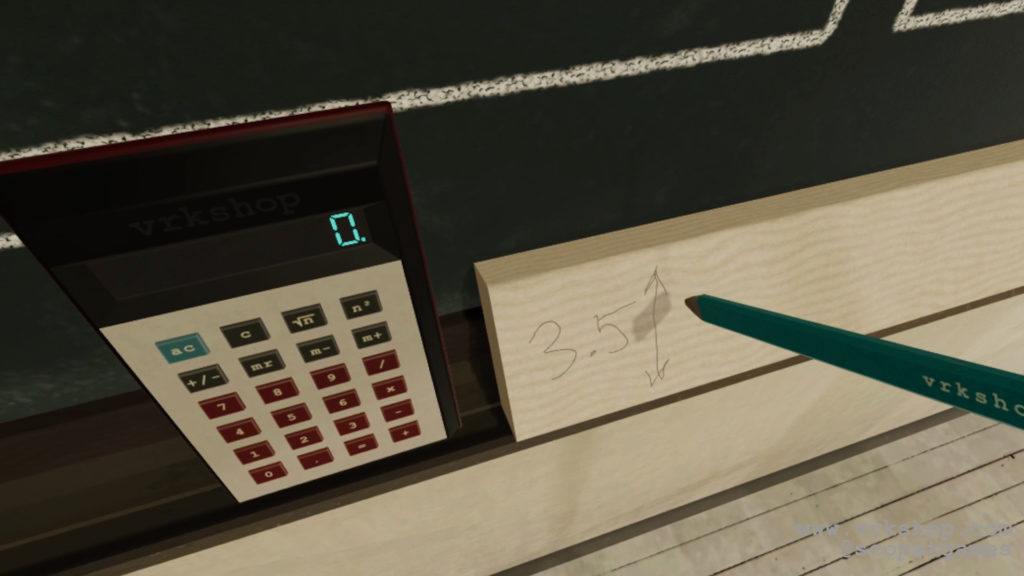
“The goal for the interactions and mechanics of the game is to strike the balance between a realistic, immersive, yet fun, experience,” states the developer on the official SteamVR page. “Extensive play testing and user feedback is required to hit that goal, which makes Early Access ideal for helping to refine (and define) the game mechanics and interactions needed to make this a challenging but satisfying experience.”
Vrkshop launches in early access July 15th. According to the developer, the game will receive continued updates leading up to its full release in early 2021. This includes additional tools, fresh crafting techniques, new free play environments, and the ability for creators to share their work with others.
Image Credit: scopatgames
The post Test Your Woodworking Skills In VR With ‘Vrkshop,’ Arriving Next Month On PC VR appeared first on VRScout.
from VRScout https://ift.tt/2VvVyN5
via IFTTT
Community Download: Which Superhero Deserves Their Own VR Game Next?
Community Download is a weekly discussion-focused articles series published (usually) every Monday in which we pose a single, core question to you all, our readers, in the spirit of fostering discussion and debate. For today’s Community Download, we want to know which superhero you’d love to see in a dedicated VR game next after Iron Man?
With Iron Man VR releasing in just a few short days on July 3rd, this Friday, it’s an exciting time for PSVR gamers. One of the most well-known and truly iconic superheroes of all-time is entering the immersive realm of VR with his own, dedicated game complete with a robust campaign and lots of depth — at least, according to the developers.
We’ve gotten the chance to take on the role of lots of iconic superheroes over the years in VR, such as Batman in Arkham VR, several Marvel characters in Marvel Powers United VR, and even as Spider-Man specifically in the free Far From Home VR experience. But now we want to imagine what another fully-fledged made-for-VR superhero game would be like that focuses on a single hero.
Superman is one of the most notoriously difficult characters to get right in games, but maybe playing as him in VR would offer that sort of empowerment you’d seek. Or, perhaps a full game building on the web-slinging of Spider-Man could be fun. Teleporting between dimensions and using your hands for magic, like Doctor Strange, could be a blast too.
Let us know what you think! Which superhero do you think deserves their own dedicated VR game next after Iron Man VR?
The post Community Download: Which Superhero Deserves Their Own VR Game Next? appeared first on UploadVR.
from UploadVR https://ift.tt/38cT4s1
via IFTTT
Mixed Reality App Immerses You In The Historic Battle Of Gettysburg
Scott Eastwood narrates this educational AR 360-degree experience from QuantumERA.
This Wednesday marks the historic 157th anniversary of the Battle of Gettysburg, a gruesome three-day conflict fought in and around the town of Gettysburg, Pennsylvania during the American Civil War. Often considered a turning point for the Union Army, Gettysburg remains one of the deadliest battles in American history, claiming the lives of roughly 46,000 – 50,000 Union and Confederate soldiers in a span of 72 hours.
Ahead of its 157th anniversary, immersive content studio QuantumERA has launched Gettysburg: A Nation Divided, a brand new app available on iOS that uses a combination of AR and 360-degree technology to transport you back in time to the year 1863 and onto the front lines of a jaw-dropping battle of epic proportions.
Users have the opportunity to immerse themselves in the chaos of battle from the perspective of both a Union and Confederate soldier via fully-animated 360-degree animations. Using their smartphones as 360 way-finders, users can explore 10 key locations scattered across the massive battlefield, each of which providing additional details such as the locations of each army and who was in command. You can also discover hidden artifacts as well as golden coins which can be used to rank up from Private all the way to General.
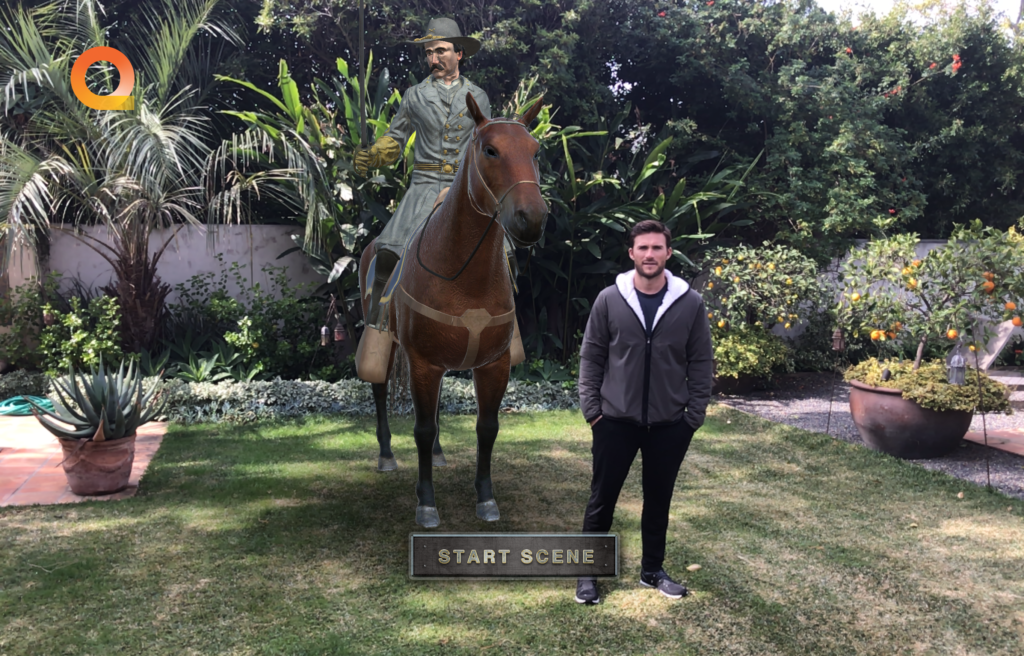
In addition to shining a light on the battle itself, QuantumERA’s app allows you the opportunity to learn more about the people effected by the conflict. Brought to life as animated avatars, you’ll hear stories from soldiers, African American journalists, and various local women just to name a few. Of course, it wouldn’t be Gettysburg without an address from the man himself. Gettysburg: A Nation Divided offers an AR recreation of President Lincoln’s famous Gettysburg Address at the Gettysburg National Cemetery.
“I was able to stand next to President Lincoln as he delivered the Gettysburg Address and joined forces at McPherson’s Ridge when the first shot in the battle was fired, all without leaving my living room,“ said history enthusiast and University of Texas student, Jed Golman.

“Honoring the Battle of Gettysburg is just as important today as it was 157 years ago,” added Michael McGar, president of QuantumERA , the content creation company that developed Gettysburg: A Nation Divided. “It was the turning point in the Civil War and the fight that led to freedom for slaves. Gettysburg shaped who we are as a people and as a country. It’s critical that we take time to remember what those before us fought for and what they achieved.”
, the content creation company that developed Gettysburg: A Nation Divided. “It was the turning point in the Civil War and the fight that led to freedom for slaves. Gettysburg shaped who we are as a people and as a country. It’s critical that we take time to remember what those before us fought for and what they achieved.”
There’s also some additional narration provided by Scott Eastwood for some reason.
“When you watch it or you interact with it, you really can retain a lot more of that information,” stated the actor (Fury, Pacific Rim: Uprising). “I think that by being able to be a part of it and be a participant, it allows you to get a perspective I think is really helpful and gives scope.”
Gettysburg: A Nation Divided is available now for $6.99 on iOS.
Image Credit: QuantumERA
The post Mixed Reality App Immerses You In The Historic Battle Of Gettysburg appeared first on VRScout.
from VRScout https://ift.tt/2BM74wO
via IFTTT
Facebook Says It Has Developed the ‘Thinnest VR display to date’ With Holographic Folded Optics
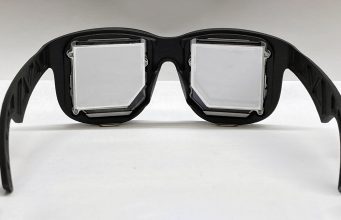
Facebook published new research today which the company says shows the “thinnest VR display demonstrated to date,” in a proof-of-concept headset based on folded holographic optics.
Facebook Reality Labs, the company’s AR/VR R&D division, today published new research demonstrating an approach which combines two key features: polarization-based optical ‘folding’ and holographic lenses. In the work, researchers Andrew Maimone and Junren Wang say they’ve used the technique to create a functional VR display and lens that together are just 9mm thick. The result is a proof-of-concept VR headset which could truly be called ‘VR glasses’.
The approach has other benefits beyond its incredibly compact size; the researchers say it can also support significantly wider color gamut than today’s VR displays, and that their display makes progress “toward scaling resolution to the limit of human vision.”
Let’s talk about how it all works.
Why Are Today’s Headsets So Big?
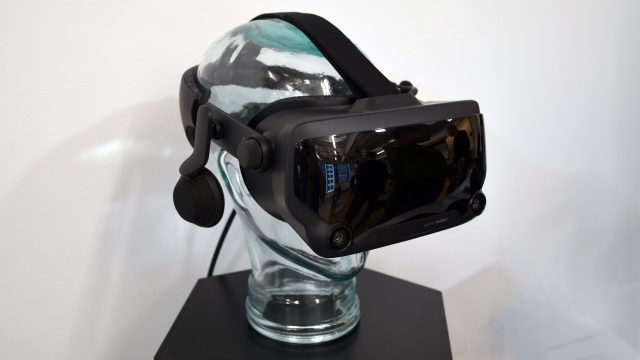
It’s natural to wonder why even the latest VR headsets are essentially just as bulky as the first generation of headsets that launched back in 2016. The answer is simple: optics. Unfortunately the solution is not so simple.
Every consumer VR headset on the market uses effectively the same optical pipeline: a macro display behind a simple lens. The lens is there to focus the light from the display into your eye. But in order for that to happen the lens need to be a few inches from the display, otherwise it doesn’t have enough focusing power to focus the light into your eye.
That necessary distance between the display and the lens is the reason why every headset out there looks like a box on your face. The approach is still used today because the lenses and the displays are known quantities; they’re cheap & simple, and although bulky, they achieve a wide field of view and high resolution.
Many solutions have been proposed for making VR headsets smaller, and just about all of them include the use of novel displays and lenses.
The new research from Facebook proposes the use of both folded optics and holographic optics.
Folded Optics
What are folded optics? It’s not quite what it sounds like, but once you understand it, you’d be hard pressed to come up with a better name.
While the simple lenses in today’s VR headsets must be a certain distance from the display in order to focus the light into your eye, the concept of folded optics proposes ‘folding’ that distance over on itself, such that the light still traverses the same distance necessary for focusing, but its path is folded into a more compact area.
You can think of it like a piece of paper with an arbitrary width. When you fold the paper in half, the paper itself is still just as wide as when you started, but it’s width occupies less space because you folded it over on itself.
But how the hell do you do that with light? Polarization is the key.
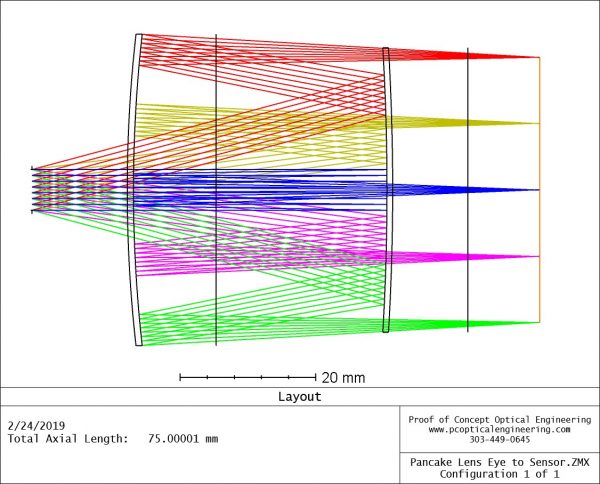
It turns out that beams of light have an ‘orientation’. Normally the orientation of light beams at random, but you can use a polarizer to only let light of a specific orientation pass through. You can think of a polarizer like the coin-slot on a vending machine: it will only accept coins in one orientation.
Using polarization, it’s possible to bounce light back and forth multiple times along an optical path before eventually letting it out and into the wearer’s eye. This approach (also known as ‘pancake optics’ allows the lens and the display to move much closer together, resulting in a more compact headset.
But to go even thinner—to shrink the size of the lenses themselves—Facebook researchers have turned to holographic optics.
Holographic Optics
Rather than using a series of typical lenses (like the kind found in a pair of glasses) in the folded optics, the researchers have formed the lenses into… holograms.
If that makes your head hurt, everything is fine. Holograms are nuts, but I’ll do my best to explain.
Unlike a photograph, which is a recording of the light in a plane of space at a given moment, a hologram is a recording of the light in a volume of space at a given moment.
When you look at a photograph, you can only see the information of the light contained in the plane that was captured. When you look at a hologram, you can look around the hologram, because the information of the light in the entire volume is captured (also known as a lightfield).
Now I’m going to blow your mind. What if when you captured a hologram, the scene you captured had a lens in it? It turns out, the lens you see in the hologram will behave just like the lens in the scene. Don’t believe me? Watch this video at 0:19 at look at the magnifying glass in the scene and watch as it magnifies the rest of the hologram, even though it is part of the hologram itself.
This is the fundamental idea behind Facebook’s holographic lens approach. The researchers effectively ‘captured’ a hologram of a real lens, condensing the optical properties of a real lens into a paper-thin holographic film.
So the optics Facebook is employing in this design is, quite literally, a hologram of a lens.
Continue Reading on Page 2: Bringing it All Together
The post Facebook Says It Has Developed the ‘Thinnest VR display to date’ With Holographic Folded Optics appeared first on Road to VR.
from Road to VR https://ift.tt/3eL0tkG
via IFTTT
Facebook Researchers Show The Most Compact VR Optics Yet
Facebook’s VR research division is presenting prototype VR optics smaller than any we’ve seen yet for the annual SIGGRAPH computer graphics conference.

The ideas behind the “holographic near-eye display” could one day enable VR headsets with sunglasses form factor- but for now this is solely research with limitations.
Why Are VR Headsets So Bulky?
The primary driver of the size and bulk of today’s VR headsets is the optical design. Magnifying a display over a wide field of view requires a large, thick lens, and focusing it at a viewable distance requires a long gap to the display. After adding the housing needed to contain this system, even the most minimal designs end up over 350 grams.

The standalone Oculus Quest, with a battery, mobile chip and lens separation adjustment, weighs 571 grams. Many people find it hurts their face after a few minutes.
Panasonic and Pico have shown off prototypes of compact headsets using “pancake lenses”, and Huawei has already launched this as a product in China. Without a tracking system or battery, these headsets end up around 150 grams.

However, these current pancake lens designs have a number of unsolved flaws. They block around 75 percent of light which can make the image look dim and washed out. They may also show faint ghost versions of the image slightly misaligned, and this “ghosting” only gets worse as you try to improve the image with a brighter source.
Holographic Lenses
Facebook Reality Labs’ new approach is a thin film where focusing is done by holographic optics instead of by the bulk of the lens. ‘Hologram’ in this context just means a physical “recording” of how light interacts with an object- in this case a lens rather than a scene.
Facebook claims the research may be able “to deliver a field of view comparable to today’s VR headsets using only a thin film for a thickness of less than 9 mm.” The total weight of the display module is claimed as just 18 grams. However, this does not include the actual laser source, and nor do any of the images Facebook provided. “For our green-only sunglasses-like prototype, we measured an overall maximum field of view of approximately 92◦ ×69◦,” according to the research paper.
By using polarization-based optical folding, these ultra-lightweight lenses can be placed directly in front of the display source.

Because holographic elements disperse light, the only practical illumination source is lasers used at specific angles and wavelengths. The researchers were able to “inject” laser light into a 2.1″ 1600×1600 LCD, replacing the backlight.
The prototype is currently monochrome, only capable of displaying the color green. The researchers have a tabletop-sized proof of concept for multi-color, and believe bringing this to the sunglasses prototype is “viable” with further engineering.

The range of colors laser light can deliver (known as the color gamut) is significantly wider than LCD displays, and in fact slightly wider than even OLED, so this would represent a milestone achievement if it could be moved into a head-worn system.
Early Research, Lofty Goals
It’s important to understand that what’s being presented here is just early research for a new kind of display system. If it ever becomes a product, it will also need a tracking system. And unless it connects to your phone with a cable, it’d likely need a battery and mobile chipset too.
Facebook describes this research as being on the same miniaturization research “path” as Half Dome 2 and 3, which it presented at Oculus Connect 6 back in October.
Those headsets are much larger than what’s being shown here, but achieved a wider field of view while also having eye tracking and variable focus. FRL says future iterations of this sunglasses prototype could also be varifocal by moving the lenses on a range of just 1 millimeter. This could theoretically be achieved with tiny piezoelectric actuators.
For virtual reality to reach Mark Zuckerberg’s lofty goal of 1 billion users, headsets need to get significantly more comfortable while increasing realism. While designs like the Rift S “halo strap” can redistribute weight, this is more of a bandage than truly addressing the issue of bulk.

Like all early research, this idea may never pan out. Practical issues may emerge. Facebook is simultaneously exploring a number of novel compact display architectures. If it can make even one work, it could do to VR what LCD panels did to CRT monitors and televisions.
Facebook’s research paper concludes:
“Lightweight, high resolution, and sunglasses-like VR displays may be the key to enabling the next generation of demanding virtual reality applications that can be taken advantage of anywhere and for extended periods of time. We made progress towards this goal by proposing a new design space for virtual reality displays that combines polarization-based optical folding, holographic optics, and a host of supporting technologies to demonstrate full color display, sunglasses-like form factors, and high resolution across a series of hardware prototypes. Many practical challenges remain: we must achieve a full color display in a sunglasses-like form factor, obtain a larger viewing eye box, and work to suppress ghost images. In doing so, we hope to be one step closer to achieving ubiquitous and immersive computing platforms that increase productivity and bridge physical distance.”
The post Facebook Researchers Show The Most Compact VR Optics Yet appeared first on UploadVR.
from UploadVR https://ift.tt/3g7Zonj
via IFTTT
Facebook reveals holographic optics for thin and light VR headsets
Steam add-on makes VR games more accessible
from Engadget RSS Feed https://ift.tt/3eIEivv
via IFTTT
Iron Man VR Trophy List Confirms 12 Mission Campaign And More
Last week Iron Man VR developer Camouflaj told us that the upcoming PSVR exclusive featured around ‘8 – 10 hours’ of AAA VR gaming. Now the Iron Man VR trophy list gives us an idea of how that time is divided up.
The trophy list debuted on Exophase over the weekend. If you want to avoid spoilers then we wouldn’t recommend reading it, but the list and icons indicate that Iron Man VR is comprised of 12 missions and an opening prologue.
We got to see that prologue and the first mission in the demo that released on PSVR a few weeks back. Remember, though, that Camouflaj is kitting out the game with optional extras and challenges, taking part in which is likely to push the game to the developer’s estimations.
Other trophies confirm that the game will feature more Flight and Combat Challenges and that you’ll have star ratings at the end of each mission. You’ll also be rewarded for killing a certain number of enemies with specific weapons and completing the campaign of different difficulties. There’s also a trophy for catching a grape in your mouth which will probably be as hard as the basketball trophy in The Walking Dead: Saints & Sinners.
Not long to go now; Iron Man VR debuts on PSVR on July 3rd. Publisher Sony has been releasing a bunch of developer diaries for the game in the run-up to launch and Camouflaj shared plenty of other details with us in our interview.
Will you be chasing every trinket on the Iron Man VR trophy list when the game launches on Friday? Let us know in the comments below!
The post Iron Man VR Trophy List Confirms 12 Mission Campaign And More appeared first on UploadVR.
from UploadVR https://ift.tt/2YJDxwA
via IFTTT

